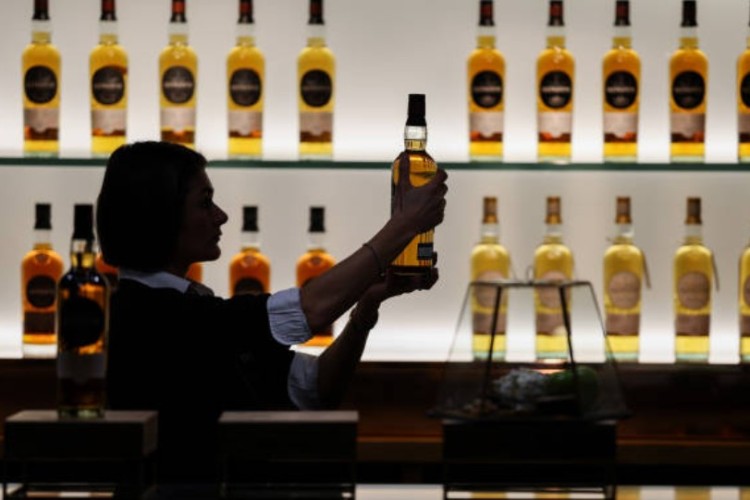The recently concluded India-UK FTA has set the stage for a sweeping transformation in bilateral trade, but nowhere is its disruptive potential more evident than in the alcoholic beverages industry. For whisky producers and consumers alike, this deal represents both an intoxicating opportunity and a sobering challenge.
A centrepiece of the trade pact is the phased reduction of tariffs on Scotch whisky imports—from an eye-watering 150% to 75%, with a glide path to 40% by the tenth year. This single clause has captured disproportionate attention, particularly from the Scotch Whisky Association, which has long lobbied for improved access to India—the world’s largest whisky market by volume.
READ | Trump eyes Nobel Peace Prize after ceasefire efforts, but Oslo may not be impressed
A pivotal market
According to the Scotch Whisky Association (SWA), India is the largest export market by volume for scotch whisky, with more than 192 million bottles exported to the country in 2024, a year-on-year growth of 14.6%. By value, India ranks fifth in size with £248 million worth of scotch whisky sold. For UK exporters, India is not just a growth market; it is the market. The scope of opportunity is massive: the Indian whisky market is valued at Rs 1.59 lakh crore ($19.16 billion) and is projected to surge to Rs 4.04 lakh crore ($48.65 billion) by 2030, driven by rising incomes, urbanisation, and a strong tilt towards premium spirits.
Whisky dominates the Indian alcoholic beverage sector, accounting for 60% of consumption by volume. Within this, the premium segment—defined as bottles priced above Rs 1,000 ($12)—grew at a blistering 45%, nearly three times the broader industry average.
For UK distillers like Diageo, Pernod Ricard, and Chivas Brothers, the FTA could be a golden tap. The duty cuts apply to both bottled-in-origin (BIO) Scotch and bulk Scotch used for blending in Indian Made Foreign Liquor (IMFL), opening up two revenue streams. Premium blends like Johnnie Walker and Chivas Regal, retailing between Rs 3,200 and Rs 3,600 ($38–$44), could see an annual volume boost of 10–15%.
The move also brings cheer to domestic players like Radico Khaitan, Allied Blenders & Distillers (ABD), and John Distilleries, who rely on bulk Scotch imports for their premium labels. Radico has announced plans to import Scotch worth Rs 250 crore ($30 million) in FY25-26, citing significant cost savings. ABD expects its super-premium line, including Officer’s Choice Blue, to become more price competitive. Analysts estimate blending costs could drop by 20–30%, unlocking greater margins and product innovation.
Consumers, too, stand to benefit. The price of BIO Scotch could drop by 10–30%, depending on how much of the savings are passed on. Meanwhile, more affordable premium IMFL options will broaden choice in a market where aspirational consumption is outpacing even GDP growth.
Growth pangs for Indian single malts
However, not everyone is raising a toast. For Indian single malt producers like Amrut Distilleries, Paul John, and Indri, the FTA could be a double-edged sword. These homegrown champions, who have earned international acclaim—including top honours at the World Whisky Awards—fear that an influx of lower-taxed Scotch could crowd them out of their own premium space. Steep tariff reduction risks disincentivising domestic expansion. The move will undermine the efforts in backward-linked sectors such as agriculture and packaging, and affect employment generation.
Even brands in the Rs 500–800 ($6–$10) segment—representing nearly 88% of the whisky market—may face pressure if mid-tier Scotch becomes affordable for the aspirational middle class. Companies like Modi Distilleries (makers of Rockford Reserve) could lose market share unless they recalibrate their price-performance ratio.
India-UK FTA: FDI, innovation, and the broader picture
The deal may, however, catalyse foreign direct investment in India’s liquor sector. With the Indian market showing enormous headroom for growth and sophistication, UK producers are expected to invest in local bottling, storage, and logistics—boosting job creation and enabling technology transfer in blending, ageing, and marketing practices.
Additionally, the growth of India’s cocktail culture, the post-pandemic revival of the hospitality sector, and digital marketing innovations—such as celebrity endorsements and app-based ordering—are expanding the market footprint of both global and domestic players.
Wines and beers not covered by FTA
Interestingly, UK wines and beers have been left out of the FTA’s tariff reductions. Domestic giants like Sula Vineyards and United Breweries are temporarily shielded. But industry bodies like the Confederation of Indian Alcoholic Beverage Companies (CIABC) warn that future FTAs—particularly with the EU or US—could widen the playing field and disrupt domestic moats.
The larger tension remains: how to balance openness with self-reliance. While trade liberalisation can boost consumer choice and competitiveness, a race to the bottom on tariffs risks damaging the very industry India is trying to nurture. CIABC has called for safeguards to ensure that liberalisation doesn’t come at the cost of domestic manufacturing growth and long-term employment.
Despite the complexities, the Indian whisky industry shows no signs of slowing down. A mix of demographics, urban migration, evolving tastes, and an affinity for premiumisation suggests that whisky is no longer just a drink—it is a lifestyle statement. Even niche segments such as American, Irish, and Japanese whiskies are finding space in urban India’s evolving bar shelves.
As India prepares to negotiate more FTAs and align trade policy with its Make in India and Atmanirbhar Bharat ambitions, it will need to tread carefully. A well-aged Scotch might be welcome, but policy decisions must mature with equal care—balancing access with protection, global aspiration with domestic preservation.

